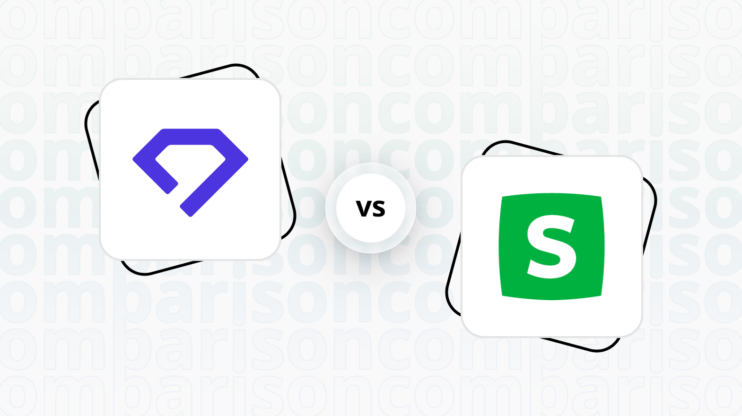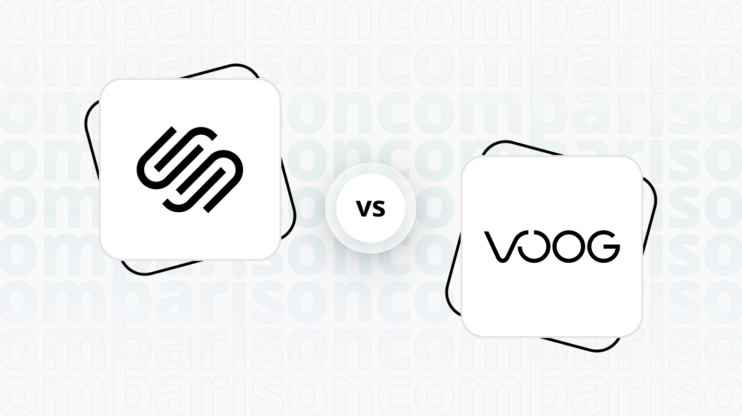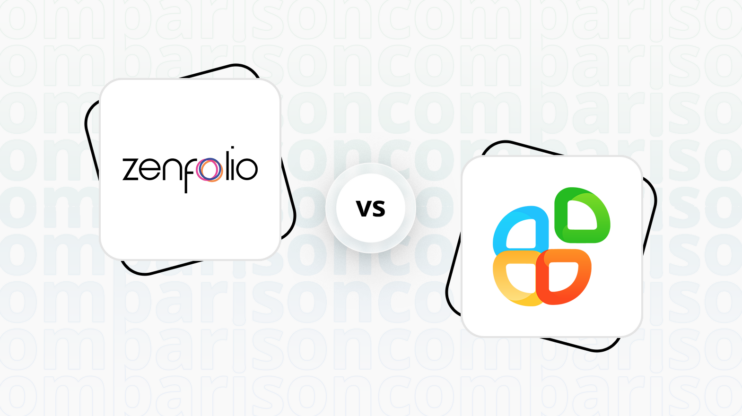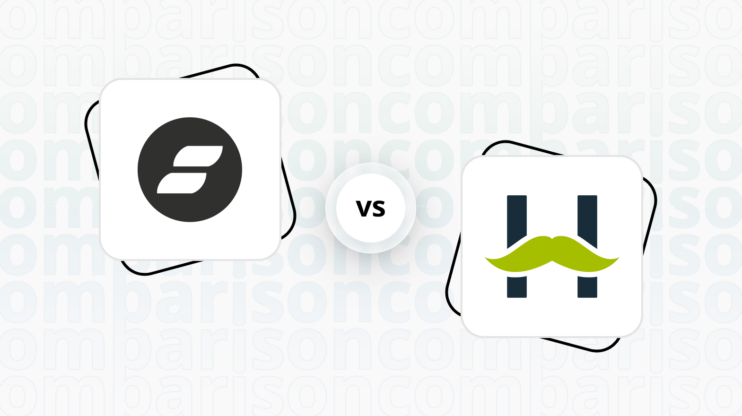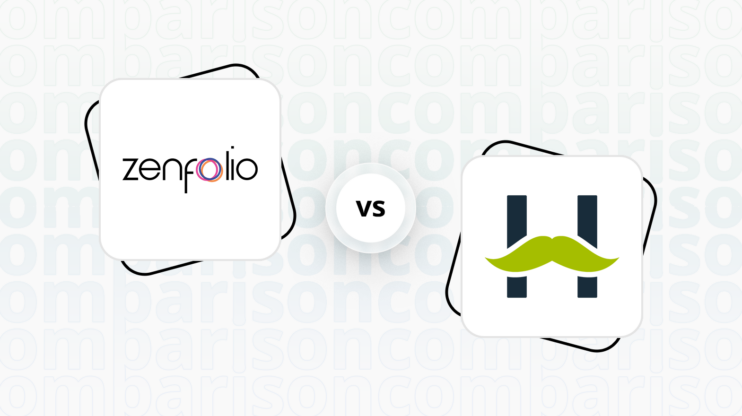Final verdict
Framer and SubHub both offer unique advantages, but they cater to different user needs.
-
Framer (Overall Grade: 7.1/10)
excels in design functionalities and AI capabilities, making it a strong choice for designers and developers looking for extensive customization and advanced design tools. It offers a comprehensive component library, AI-driven content generation, and a user-friendly drag-and-drop interface. However, it has a learning curve for beginners and lacks native ecommerce features, which may limit its appeal for users seeking a straightforward ecommerce solution. -
SubHub (Overall Grade: 5.6/10)
is tailored for content creators and entrepreneurs aiming to build and monetize membership sites. It simplifies the process of setting up subscription models and managing member access, making it an ideal choice for those looking to grow a membership-based business. While it scores higher in ease of use and customer support, it lacks the advanced design and AI features that Framer offers, making it less suitable for users seeking extensive customization and design flexibility.

|

|
|
|---|---|---|
|
Design functionalities & templates |
8.5 |
6.8 |
|
Ease of use |
7.1 |
7.7 |
|
Ecommerce |
5.9 |
5.9 |
|
Website Editors |
7.6 |
6.9 |
|
Product testing options |
6.2 |
7.0 |
|
Price |
7.7 |
6.8 |
|
Hosting quality |
7.1 |
5.5 |
|
Website speed optimization |
7.4 |
5.6 |
|
Plugins and integrations |
7.6 |
5.7 |
|
Marketing features |
7.2 |
5.7 |
|
Customer support |
5.6 |
6.3 |
|
Security |
8.2 |
4.0 |
|
AI capabilities |
7.6 |
0 |
|
User Management |
7.4 |
5.2 |
Best for ecommerce
 5.9
5.9
 5.9
5.9
Verdict
: Framer and SubHub both score equally in ecommerce capabilities, but they cater to different needs. Framer is better for design flexibility and integration, while SubHub excels in built-in ecommerce features for membership sites.
-
Framer
: Framer offers a unique blend of AI-driven design and customization, making it suitable for users who need extensive design flexibility. However, it lacks native ecommerce features and relies on integrations like Ecwid for online store functionalities. This makes it ideal for those who prioritize design and are comfortable with third-party integrations. -
SubHub
: SubHub is tailored for membership sites, offering built-in ecommerce features such as sales of physical and digital products, and pay-per-view content. It simplifies the process of setting up and managing a membership-based business, making it a great choice for content creators and entrepreneurs looking to monetize their content without needing advanced technical skills.
Best for informational & business websites
 7.5
7.5
 7.2
7.2
Verdict
: Framer slightly edges out SubHub for informational business websites due to its advanced design functionalities and comprehensive customization options, despite a steeper learning curve.
-
Framer
: Framer is a versatile website builder that combines AI-driven design with an intuitive interface, making it suitable for both beginners and experienced designers. It offers extensive customization through a comprehensive component library and AI tools for content generation and localization. While it has a learning curve for beginners and lacks native e-commerce features, its robust design and prototyping capabilities make it a strong choice for creating visually appealing and highly functional informational websites.
Score: 7.5
-
SubHub
: SubHub is tailored for creating and managing membership sites, making it ideal for content creators and entrepreneurs looking to build a community and monetize their content. It simplifies the process of setting up subscription models and managing member access, emphasizing ease of use and efficiency. However, it lacks the extensive design and prototyping features that Framer offers, making it less versatile for purely informational business websites.
Score: 7.2
Detailed comparison
Design functionalities & templates
Design FunctionalitiesRepresents how well each platform allows for creative design and customization of websites.Score Components:
- Template Variety (30%): Range and quality of design templates.
- Customization (30%): Flexibility and options for design alterations.
- User Interface (20%): Ease and intuitiveness of the design process.
- Responsiveness (10%): Adaptability to different devices and screen sizes.
- Innovation (10%): Unique design features and tools.
 8.5
8.5
 6.8
6.8
🏆
Winner: Framer.
If you’re looking for a platform that offers more creative control and a wide array of design features, Framer is the preferred choice.
Framer offers a diverse array of over 1,000 customizable website templates and designs, catering to various industries and project requirements. It stands out for its robust design and prototyping features, including responsive design capabilities, real-time collaboration, and extensive import options from other design tools.
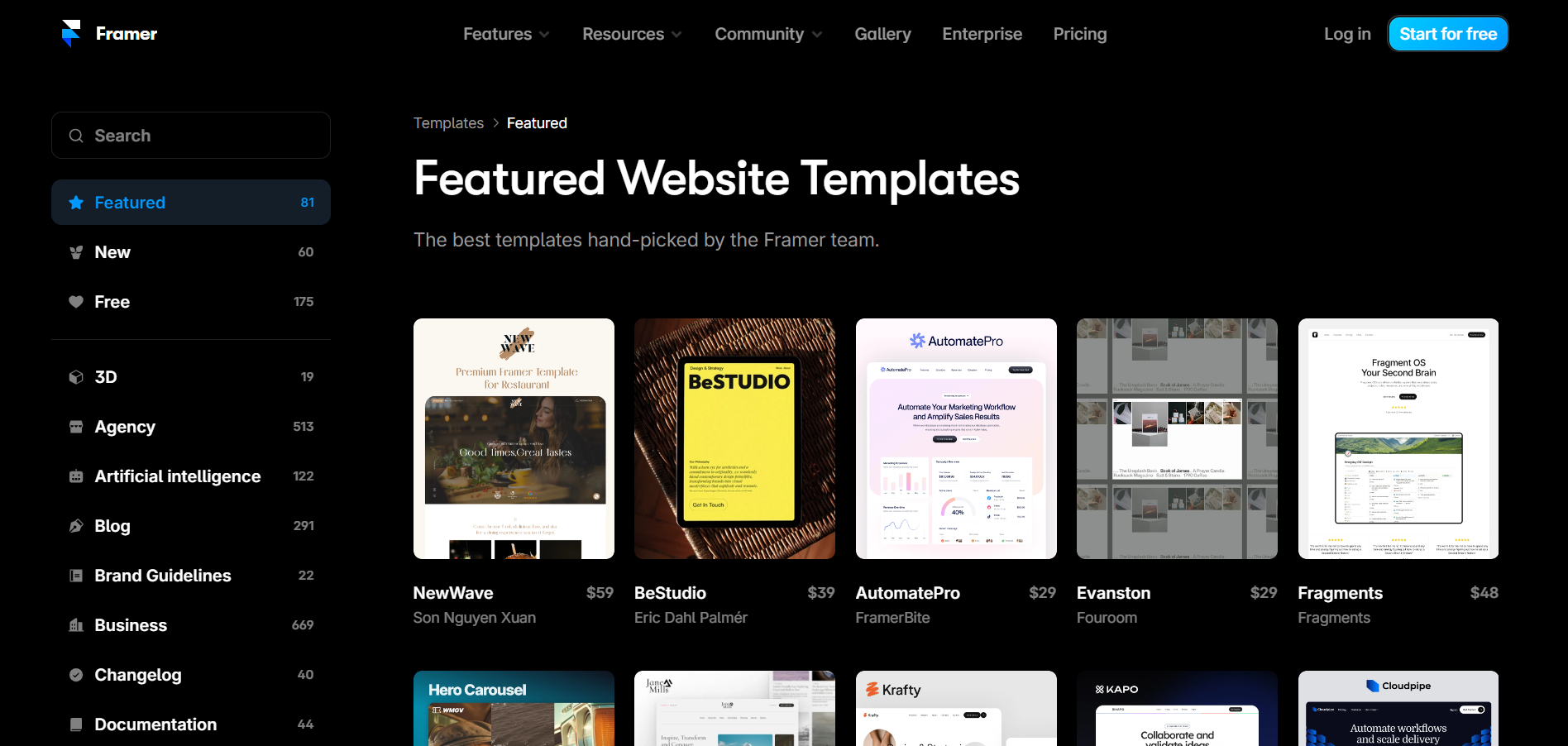

Compared to Framer, SubHub offers a variety of customizable membership website templates designed to cater to different needs and themes. However, it lacks the extensive design and prototyping features that Framer offers.
Get a head start on website creation with AI
Create a custom website tailored to your business needs 10X faster with 10Web AI Website Builder!
Ease of use
Ease of useReflects the platform’s overall user-friendliness.Score
Components:
- Learning curve (40%): Quickness and ease of getting started.
- Interface design (30%): Simplicity and intuitiveness of layout.
- User guidance (20%): Quality of tutorials and support.
- Flexibility (10%): Adaptability to various user skills.
 7.1
7.1
 7.7
7.7
🏆 Winner: SubHub
. With a score of 7.7, SubHub edges out Framer (7.1) in terms of ease of use. SubHub’s platform is designed specifically for building membership websites and online courses, emphasizing simplicity and efficiency. Framer, while offering a comprehensive component library and AI tools, may present a learning curve for beginners due to its advanced features.
Learning Resources
🏆 Winner: Framer
. Both platforms offer solid learning resources, but Framer provides a wider range of resources, including detailed courses and lessons on Framer Academy, practical tutorials, video lessons, and an extensive collection of free resources. SubHub, on the other hand, offers video guides and tutorials, a comprehensive FAQ section, and customer support.
For ecommerce
EcommerceMeasures the platform’s effectiveness in supporting online business activities.Score Components:
- Ecommerce themes and templates (20%): Variety and design of templates.
- Product management (25%): Ease of managing and organizing products.
- Payment options (25%): Variety and convenience of payment methods.
- Ecommerce features (20%): Features for managing an ecommerce store.
- Integration (10%): Compatibility with external e-commerce tools and services.
 5.9
5.9
 5.9
5.9
Framer and SubHub both offer ecommerce capabilities, but in different ways. Framer does not have native ecommerce features but allows integration with Ecwid’s free shopping cart extension for online store functionalities. SubHub, on the other hand, has built-in ecommerce features, including sales of physical goods, digital products, and pay-per-view content.

|

|
|
|---|---|---|
|
Ecommerce themes and templates |
7.0 |
3.0 |
|
Product page customization |
5.5 |
6.5 |
|
Payment processing and commissions |
6.5 |
7.0 |
|
POS capabilities |
3.0 |
0.0 |
|
Payment gateways |
6.0 |
6.0 |
|
Product numbers |
6.0 |
5.0 |
|
Additional ecommerce features |
5.5 |
4.5 |
Framer ecommerce features:
- Ecwid integration
SubHub ecommerce features:
- Paypal and Stripe integration
- Physical and Digital product listings
- Pay-per view products
Ecommerce themes & templates
Framer offers 97 website templates specifically designed for ecommerce, providing a wide range of options for various business needs. These templates are highly customizable, allowing for easy adjustments to colors, fonts, layouts, and integration with essential ecommerce tools. SubHub, however, does not have ecommerce specific templates.
Product page customization
Framer primarily focuses on expanding design possibilities for ecommerce. However, it lacks inherent ecommerce functionalities and instead heavily depends on integrating with platforms such as Shopify and Ecwid. Additionally, while Framer allows for some customization of product pages, these modifications are generally limited to design and layout alterations.
On the other hand, SubHub offers a range of product page customization options, allowing for the addition of physical items, digital downloads, and pay-per-view content. Features include the ability to manage product variants, upload images, and set visibility preferences. Users can also implement SEO strategies through meta tags and manage tax settings.
Payment processing
When it comes to payment processing, Framer supports Stripe, enabling a wide range of payment options including one-time payments, subscriptions, and more, without requiring coding. SubHub supports two main payment gateways: Stripe and PayPal. These integrations allow for secure payment processing for subscriptions and store items using debit or credit cards. The platform itself does not charge commissions on transactions.
Considering the features, availability, cost, and flexibility, both Framer and SubHub offer viable ecommerce solutions, each with its own strengths and limitations. Users should carefully consider these aspects to choose the platform that best meets their ecommerce needs.
Website Editors
Website EditorsEvaluates the platforms’ website building and editing capabilities.Score Components:
- Customization tools (40%): Range and power of editing features.
- Editor usability (30%): User experience within the editor.
- Design flexibility (20%): Freedom in layout and design changes.
- Update and maintenance ease (10%): Simplicity of updating and maintaining the site.
 7.6
7.6
 6.9
6.9
🏆
Winner: Framer
. Framer, with a score of 7.6, is a website builder that blends AI-driven design with an intuitive user interface, catering to both novices and experienced designers. It offers a drag-and-drop interface, extensive customization through a comprehensive component library, and AI tools for content generation and localization. Framer’s website builder editor is designed for high-fidelity prototyping and complex animations, catering to both designers and developers. It offers a robust set of tools for creating interactive and responsive designs, including a wide array of pre-built components, real-time collaboration features, and the ability to integrate with other design tools and workflows.
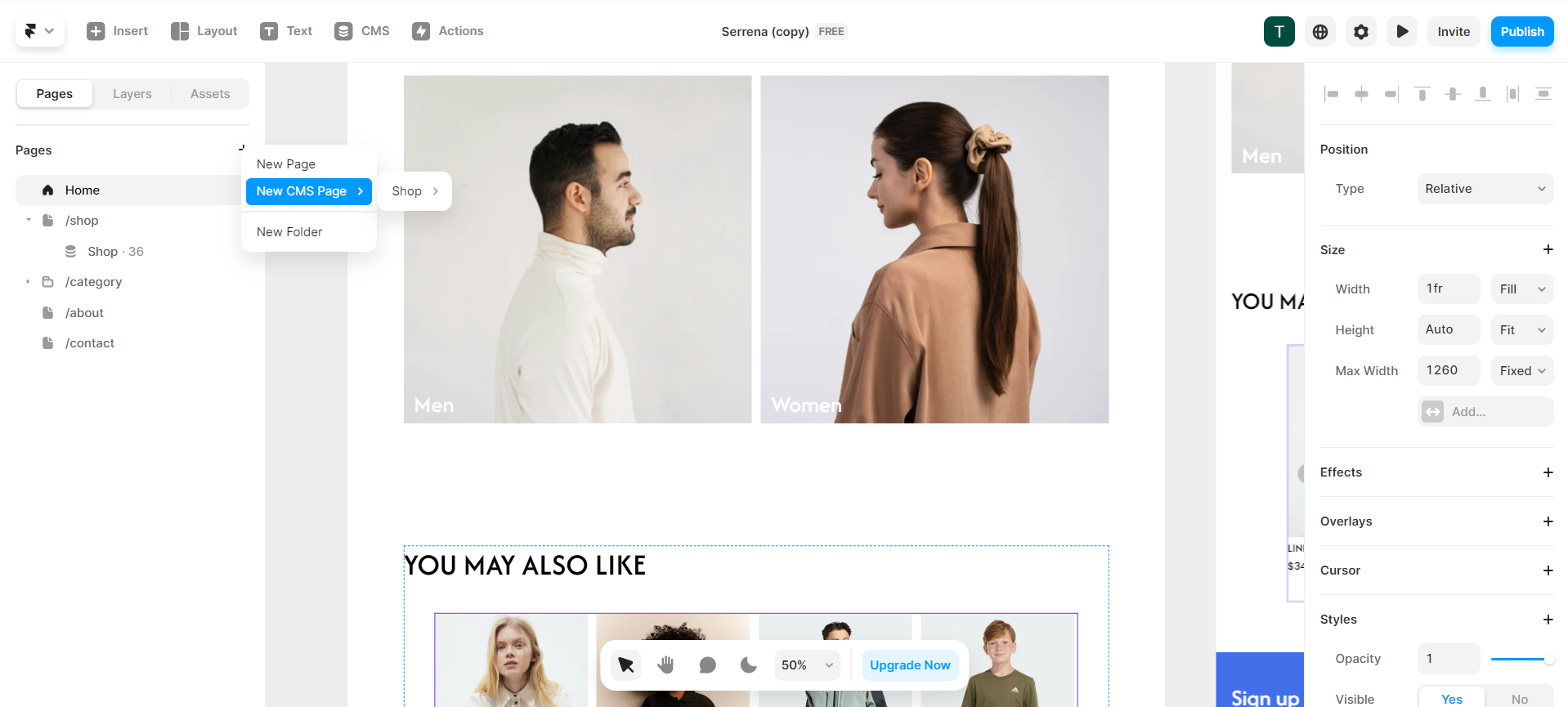
SubHub, scoring 6.9, is a website builder designed specifically for creating and managing membership sites. It offers a range of tools tailored for content creators and entrepreneurs who aim to build a community and monetize their content. SubHub offers a user-friendly website builder tailored for creating and managing membership sites, catering to content creators and entrepreneurs aiming to monetize their offerings. Its features encompass customizable templates, diverse content publishing options, and flexible subscription plans with seamless integration for recurring revenue through payment processors.
Mobile editor/app
 4.5
4.5
 4.0
4.0
🏆
Winner: Framer
. Both Framer and SubHub do not have a dedicated mobile editor app. However, they allow users to manage some content on their websites using the mobile browser version. Despite this, both platforms have limitations when it comes to mobile editing, such as not being able to change the layout and design of the website on mobile. Despite these limitations, Framer scores slightly higher than SubHub in the mobile editor category, making it the winner in this comparison.
Product testing options
Product Testing OptionsAssesses the options for trying out platform features before commitment.Score Components:
- Trial quality (40%): Extent and usefulness of the trial or free version.
- Feature accessibility (30%): How many features are available to test.
- Trial duration (20%): Length of the trial period.
- Ease of transition (10%): Smoothness of moving from trial to paid plans.
 6.2
6.2
 7.0
7.0
Overall Result
:
SubHub Wins
. SubHub scores 7.0, slightly higher than Framer’s 6.2, in product testing options. SubHub offers a 14-day free trial, during which users can test premium features. It also provides a 7-day money-back guarantee. On the other hand, Framer offers a free version where some features can be tested, but it does not offer a trial version. The money-back guarantee is only available in some regions.

|

|
|
|---|---|---|
|
Free Plan |
Yes | No |
|
Trial Duration |
No |
14 days |
|
Testing Premium Features |
Some features with free version |
During the free trial |
|
Money Back Guarantee |
Only in some regions |
7-day money back guarantee |
Price
PriceLooks at the cost-effectiveness and value for money of each platform.Score Components:
- Plan value (40%): What each pricing tier offers.
- Transparency and clarity (30%): Clearness of pricing structures.
- Flexibility of plans (20%): Range of options to suit different budgets.
- Hidden costs (10%): Additional expenses not included in the plan.
 7.7
7.7
 6.8
6.8
Framer offers a wider range of pricing plans and a higher discount on annual billing, making it a more flexible option for different budgets. However, SubHub’s pricing is more straightforward and may be more suitable for content creators and entrepreneurs looking to build a membership-based business.

|

|
|
|---|---|---|
|
Free |
Free (Free/month): Allows 3 websites built on a framer.website subdomain with Framer branding in the footer. Limited to 1,000 traffic visitors and 1,000 CMS items. |
No offering at this amount. |
|
$0-$10 |
Mini ($10/month): Removes Framer branding, allows using a custom domain, includes collaboration with an additional cost for extra editors, custom code embedding, e-commerce support, and limited CMS items. Offers a monthly visitor limit of 2,000 and 1GB bandwidth. Value for price: 6.5 |
No offering at this amount. |
|
$10-$20 |
Basic ($20/month): Offers all Mini features plus increased limits for CMS items (1,000) and traffic (10,000 visitors per month), along with 10GB bandwidth. Value for price: 7.5 |
No offering at this amount. |
|
$30-$50 |
Pro ($30/month): Enhances Basic plan features with a significant increase in CMS items (10,000), traffic (100,000 visitors per month), and bandwidth (100GB), among other advanced features. Value for price: 8.5 |
Starter ($47/month): Up to 500 members, 5 GB storage, secure payment processing, course builder, 5 landing pages, e-commerce. Value for price: 6.5 |
|
$90-$100 |
No offering at this amount. |
Pro ($97/month): Up to 2000 members, 50 GB storage, removes SubHub branding, 15 landing pages, along with Starter features. Value for price: 7.5 |
|
$100+ |
No offering at this amount. |
Premium ($147/month): Unlimited members, 200 GB storage, email white labelling, 30 landing pages, plus all Pro features. Value for Price: 8.5 |
location. As a result in rare cases the prices displayed here can differ from the ones you see on their
websites.
Hosting quality
Hosting
qualityExamines the reliability and performance of the hosting solutions.Score Components:
- Uptime (40%): Consistency and reliability of website availability.
- Speed (30%): Loading times and performance.
- Bandwidth and storage (20%): Sufficiency of resources provided.
- Data centers (10%): Quality and distribution of hosting infrastructure.
 7.1
7.1
 5.5
5.5
🏆
Winner: Framer
Framer offers cloud hosting with a 99.9% uptime and has 4 data centers globally. SubHub, on the other hand, offers managed cloud hosting but does not provide uptime statistics or guarantees and does not disclose the locations of its data centers. This gives Framer a higher hosting quality score.

|

|
|
|---|---|---|
|
Do they offer hosting? |
Yes, included in all their plans, with 100MB to 100GB SSD storage depending on the plan, and from 3 to 90 day version history. |
Yes, from 5GB to 200GB storage limitation depending on the plan and daily backups. |
|
Data Centers: |
4 data centers globally: 2 in US, 1 in Ireland, 1 in Singapore |
Subhub does not disclose the locations of its data centers |
|
Type of hosting: |
Cloud Hosting |
Managed Cloud Hosting |
|
Uptime: |
99.9% |
Subhub does not provide uptime statistics or guarantees |
|
Uptime Guarantee: |
Only for enterprise plan, 99.99% |
Subhub does not provide uptime statistics or guarantees |
Website Speed Optimization
Website Speed OptimizationEvaluates optimization of website loading timesScore Components:
- PageSpeed Score (30%): Google’s score indicating performance optimization.
- Loading Time (30%): The average time until a website is fully interactive.
- Mobile Optimization (15%): Optimization effectiveness for mobile devices.
- Resource Optimization (15%): Optimizing images, scripts, and other heavy resources.
- CDN Usage (10%): Use of CDN to enhance speed across geolocations.
 7.4
7.4
 5.6
5.6
🏆 Winner: Framer
Both Framer and SubHub have strategies for website speed optimization, but Framer has a higher score and provides more strategies. Framer also emphasizes on LCP, FID, CLS improvements for Core Web Vital improvements, while SubHub does not provide any information on their Core Web Vitals improvements.

|

|
|
|---|---|---|
|
Focus |
Code Minification, Pre-Rendering, Caching, Image optimization |
Image Optimization, Caching, Mobile Optimized design |
|
Performance Tools |
Google Lighthouse, PageSpeed Insights |
Google PageSpeed Insights |
|
Key Strategies |
Code Minification, Pre-Rendering, Caching, Image optimization |
Image Optimization, Caching, Mobile Optimized design |
|
Load Times |
Varies depending on optimization and website complexity |
Varies depending on optimization and website complexity |
|
Page Speed Scores Range |
Varies depending on optimization and website complexity |
Varies depending on optimization and website complexity |
|
Core Web Vitals Improvement |
Emphasis on LCP, FID, CLS improvements |
No information provided |
Framer’s approach to enhancing site speed includes code minification, pre-rendering, caching, and image optimization. This approach leverages Framer’s fast servers and CDN network to boost load speed. Framer also emphasizes on LCP, FID, CLS improvements for Core Web Vital improvements.
On the other hand, SubHub’s approach to enhancing site speed includes image optimization, caching, and mobile optimized design. However, SubHub does not provide any information on their Core Web Vitals improvements.
Get a head start on website creation with AI
Create a custom website tailored to your business needs 10X faster with 10Web AI Website Builder!
Plugins and integrations
Plugins and integrationsMeasures the range and effectiveness of additional plugins and integrations.Score Components:
- Variety of options (40%): Range of available add-ons.
- Integration smoothness (30%): Ease of integrating plugins into the site.
- Quality of plugins (20%): Functionality and reliability of the options.
- Custom integration capabilities (10%): Support for custom or third-party integrations.
 7.6
7.6
 5.7
5.7
🏆 Winner: Framer.
Framer scores 7.6, offering a variety of plugins that cater to different needs such as forms, video & animation, social media integration, audio, and utility functions. These plugins include integrations with platforms like Vimeo, MP4, Lottie, GIPHY, Instagram, Twitter, Google Maps, Trustpilot, Spotify, SoundCloud, Apple Music, and more.
On the other hand, SubHub, with a score of 5.7, is designed with a focus on simplicity and integrated functionalities for building membership-based websites. It offers a set of built-in features, including customizable designs, member management, and subscription management, along with limited third-party integrations primarily with MailChimp, Google Analytics, and payment gateways like Stripe and PayPal.
While Subhub provides a comprehensive toolkit for creating and managing membership sites, its range of external integrations might be seen as limited compared to other website builders.
Marketing Features
Design FunctionalitiesRepresents how well each platform allows for creative design and customization of websites.Score Components:
- Template Variety (30%): Range and quality of design templates.
- Customization (30%): Flexibility and options for design alterations.
- User Interface (20%): Ease and intuitiveness of the design process.
- Responsiveness (10%): Adaptability to different devices and screen sizes.
- Innovation (10%): Unique design features and tools.
 7.2
7.2
 5.7
5.7
🏆
Overall Winner: Framer
. Framer stands out for its comprehensive SEO tools, integration with Mailchimp for email marketing, and robust analytics and reporting suite. SubHub, while lacking in social media integration, offers built-in tools for ads and promotions, making it a good choice for membership-based businesses.

|

|
|
|---|---|---|
|
SEO Tools |
|
|
|
Email Marketing |
Yes, through integration of third-party services such as Mailchimp |
Yes, both built in and through integration of Mailchimp |
|
Blogging |
|
|
|
Social Media Integration |
|
|
|
Analytics and Reporting |
Yes, only on higher plans |
|
|
Ads and Promotions |
|
|
Customer Support
Customer supportEvaluates the quality and availability of support options.Score Components:
- Response time (40%): Speed of support responses.
- Support quality (30%): Effectiveness and helpfulness of the support.
- Availability (20%): Range of support channels (phone, chat, email).
- Resource richness (10%): Quality of self-help and educational materials.
 5.6
5.6
 6.3
6.3
🏆 Winner: SubHub
. In the Framer vs SubHub comparison, SubHub takes the lead with a higher customer support score. SubHub offers email support and a support portal for detailed queries, along with an FAQ section for quick answers. This ensures users have multiple avenues to seek help and resolve issues efficiently.
Framer, on the other hand, provides self-help options through a community forum and knowledge base, with additional support available via email. However, the lack of detailed information about their support hours and availability may be a drawback for users needing timely assistance. While Framer does offer dedicated support for enterprise customers, the specifics are not well-documented, making SubHub the more reliable choice for customer support.
Security
SecurityLooks at the platforms’ security measures and data protection.Score Components:
- Data protection (40%): Safeguards for user and customer data.
- SSL and encryption (30%): Implementation of secure connections.
- Compliance (20%): Adherence to industry security standards.
- Regular updates (10%): Frequency of security updates and patches.
 8.2
8.2
 4.0
4.0
🏆
Winner: Framer
. Framer’s security measures are more comprehensive and transparent than SubHub’s. Framer uses Amazon Web Services for hosting and ensures data encryption at rest. It also classifies data into different categories and restricts access based on the principle of least privilege. Framer also emphasizes product security through secure development practices, external security testing, and a bug bounty program.
On the other hand, SubHub’s security measures are not as transparent. While they do have a privacy policy that outlines their approach to data protection, they do not disclose any specific information about the website security measures they provide.
AI Capabilities
AI capabilitiesMeasures the effectiveness of AI-driven features and tools.Score Components:
- Automation efficiency (40%): Impact of AI on streamlining processes.
- Personalization (30%): AI-driven customization for users or customers.
- AI-Assisted design (20%): Role of AI in website design and functionality.
- Data analysis (10%): Use of AI in interpreting user data and analytics.
 7.6
7.6
 0
0

|

|
|
|---|---|---|
|
AI Builder |
Framer’s AI builder simplifies the process of creating and optimizing web content |
|
|
AI Ecommerce features |
|
|
|
AI Content Generation |
Framer’s AI enhances website creation with features like AI Translation, Text Rewrite, and Headline Generator |
|
|
Additional AI features |
Framer’s AI Style and AI Photo Generating and Editing tools offer customization and image editing capabilities |
|
🏆 Winner: Framer
. Framer, with a score of 7.6, utilizes AI to enhance the website creation process. Its AI features focus on content generation, translation, and photo editing, making it a versatile tool for web design.
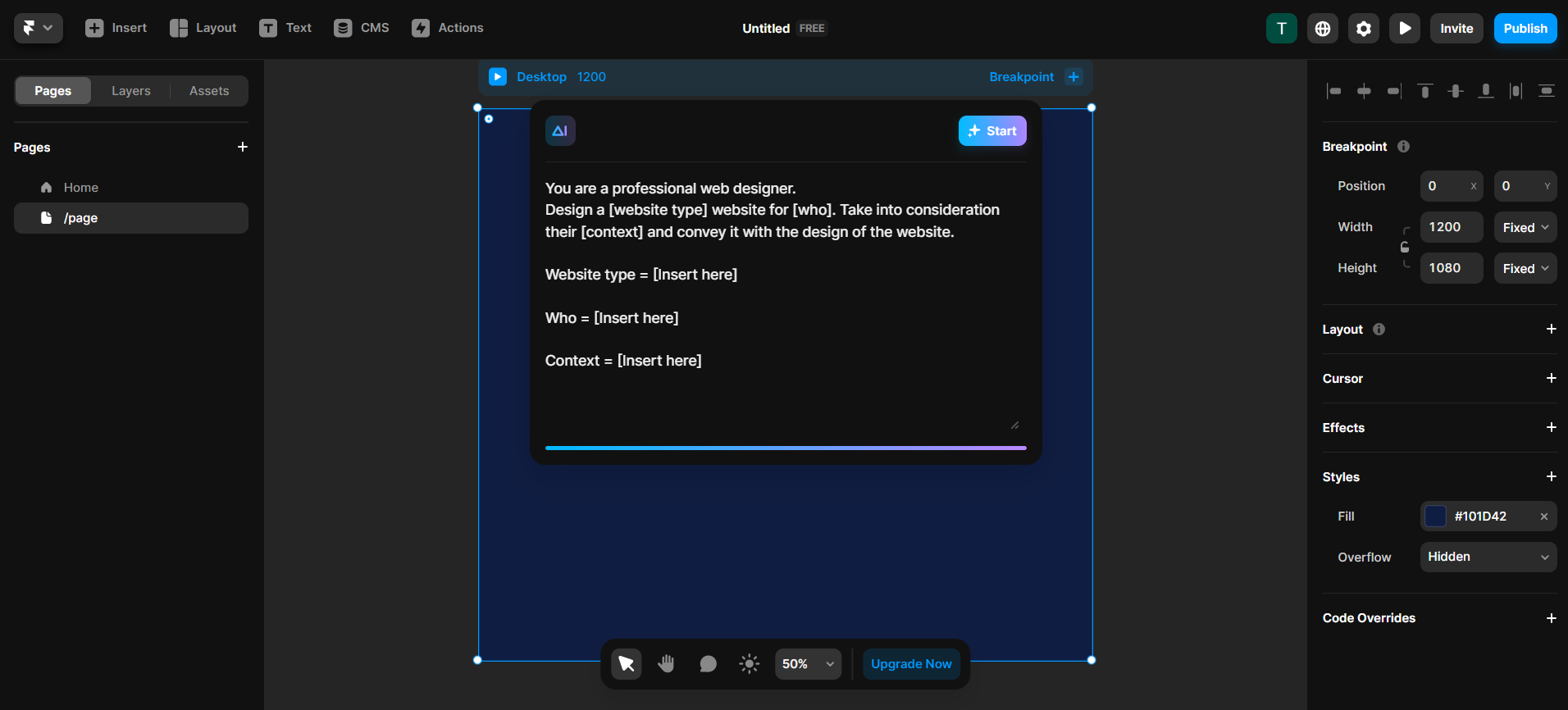
SubHub, on the other hand, does not have any AI capabilities, hence its score is 0. While SubHub is a great tool for creating and managing membership sites, it lacks the AI features that Framer offers.
User Management
User ManagementAssesses the platforms’ capabilities in managing user roles, permissions, and accessibility.Score Components:
- Role Customization (40%): Flexibility in creating and defining user roles and
permissions. - Ease of Management (30%): User interface and tools for managing users.
- Access Control (20%): Effectiveness of access control measures for different user
levels. - Scalability (10%): Ability to manage a growing number of users efficiently.
 7.4
7.4
 5.2
5.2
🏆 Winner: Framer
. Framer and SubHub offer different approaches to user management.
- Framer supports team collaboration with different plans allowing a varying number of editors; the Team Basic plan allows up to 5 editors, while the Team Pro plan supports up to 10 editors. These plans come with additional features like live collaboration, comments, file storage, and extended version history.
- SubHub allows multiple user accounts, however the platform does not specify how many accounts are supported.
Framer User Roles and Access Levels:
| Role | Description | Access Highlights |
|---|---|---|
| Designer | Focuses on the aesthetic and UI/UX aspects of the website. | Can create and modify design elements, utilize animation libraries like Framer Motion, and implement accessibility settings. |
| Content Editor | Manages and curates content for the website, including text, images, and other media. | Can edit CMS content, use localization features for different regions, and modify SEO settings. |
| Developer | Works on more technical aspects, such as custom code and integrations. | Has access to deploy options, can use custom domains, manage project permissions, and apply custom code for further optimization. |
| Project Manager | Oversees the project, coordinating between different roles and ensuring the project meets its deadlines and goals. | Can invite collaborators, assign roles and permissions, and manage versions and rollbacks for efficient site management. |
| Collaborator (General) | A role that can encompass various levels of access based on project needs, including design, content, and deployment tasks. | Access can be customized to include a mix of design, content, and deploy permissions based on the project’s needs and the individual’s role within the team. |
SubHub User Roles and Access Levels:
| Role | Description | Access Highlights |
|---|---|---|
| Administrator | Full access to the platform except for Homepage and Course Editor. | Can manage all aspects of the platform, including content, store, and member management. |
| Content Management | Focuses on managing and organizing content within the platform. | Can access and manage content-related features but does not have access to Homepage or Course Editor. |
| Store (access only) | Specializes in handling the platform’s store features. | Limited to store management functions; no access to Homepage, Course Editor, or member management. |
| Member Manager (access only) | Oversees member accounts, roles, and subscriptions. | Can manage members and their subscriptions but cannot access Homepage, Course Editor, or store management. |
| *Origin Admin Email | The initial administrator with the highest level of access, including Homepage and Course Editor. | Exclusive access to Homepage and Course Editor, on top of what the Administrator role provides. |
Additional Features

|

|
|
|---|---|---|
|
SSL Certificate |
|
|
|
Custom Domain |
|
|
|
Free Custom Domain Included |
|
|
|
International Domains |
|
|
|
Mobile Responsive |
|
|
|
Page Speed |
|
|
|
Website Builder Mobile App |
|
|
|
Convert a Website To An App |
|
|
|
Website Analytics |
|
|
|
Multilingual Sites |
|
|
|
Multiple Users |
|
|
User Feedback
Framer receives high marks for its user-friendly, no-code approach to web and prototype design, offering extensive tutorials, templates, and drag-and-drop functionalities that expedite the design process. Users appreciate its integration with tools like Figma, AI-generated responsive designs, and real-time collaboration features. Critiques focus on a steep learning curve for newcomers and limitations in customer support and features without premium access. Despite these drawbacks, Framer is lauded as a powerful design tool that enhances creativity and efficiency in web development.
User feedback on SubHub presents a mix of positive and negative experiences, emphasizing the platform’s feature-rich environment and customizable templates. Users appreciate the flexibility and the quality of customer service, highlighting the platform’s continual updates and support as key benefits. However, some users express dissatisfaction with aspects such as the platform’s interface, lack of community features, and service fees for ticket resale. Concerns were also raised about the custom design service and mobile-friendly solutions taking longer than expected.
The making of this blog
We followed a clear, step-by-step process to write and research this article.
FAQ
Which platform is better for creating a membership site, Framer or SubHub?
Can I use Framer for ecommerce?
Is Framer more user-friendly than SubHub?
Which platform offers better design and customization options?
How do Framer and SubHub compare in terms of price?
Which platform has better customer support?
Do Framer and SubHub offer AI capabilities?
Can I manage a team with either Framer or SubHub?
Which platform is recommended for high-quality hosting and website speed?
Are there any significant differences in plugins and integrations between Framer and SubHub?










